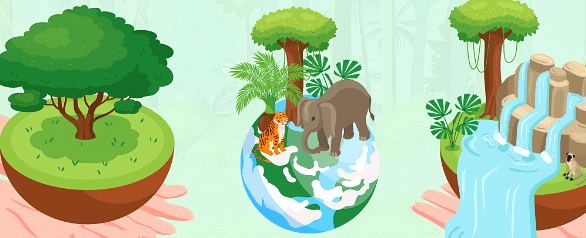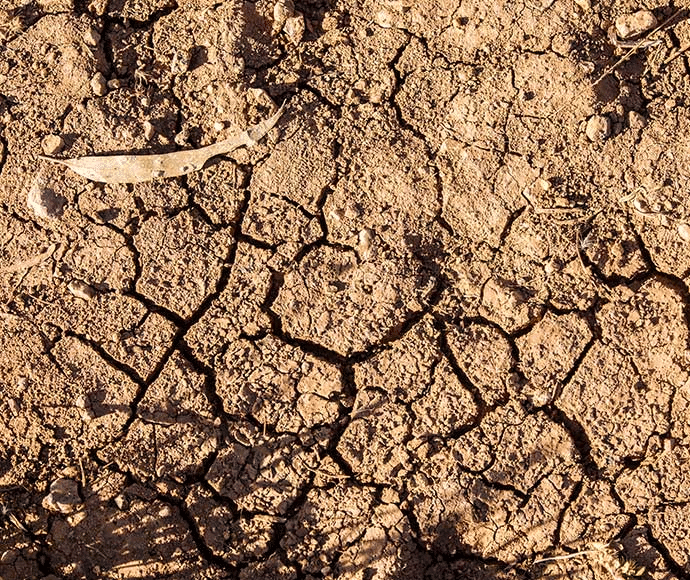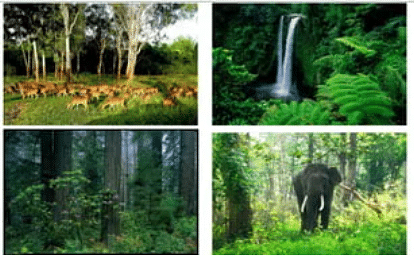Land, Soil, Water, Natural Vegetation and Wildlife Resources Class 8 Worksheet Social Science
| Table of contents |

|
| MCQ |

|
| Name in One Word |

|
| True or False |

|
| Short Answer Questions |

|
| Long Answer Questions |

|
MCQ
Q1: What is the primary factor influencing the growth of vegetation?
(a) Human interference
(b) Temperature and moisture
(c) Altitude
(d) Soil fertility
Ans: (b) Temperature and moisture
The growth of vegetation primarily depends on temperature and moisture levels in an area. These factors determine the type of vegetation that can thrive in a particular region.

Q2: Which method of irrigation is most effective in dry regions with high rates of evaporation?
(a) Sprinkler irrigation
(b) Drip irrigation
(c) Surface irrigation
(d) Sub-surface irrigation
Ans: (b) Drip irrigation
Drip irrigation is the most effective method in dry regions with high rates of evaporation because it delivers water directly to the roots of plants, minimizing water loss due to evaporation.

Q3: What is the main reason for the uneven distribution of population around the world?
(a) Variation in climate
(b) Availability of land and water resources
(c) Technological advancements
(d) Cultural differences
Ans: (b) Availability of land and water resources
The uneven distribution of population is mainly due to variations in the availability of land and water resources. Regions with abundant resources tend to have higher populations.
Q4: Which factor is NOT responsible for soil degradation?
(a) Deforestation
(b) Overgrazing
(c) Afforestation
(d) Soil erosion
Ans: (c) Afforestation
Afforestation, which involves planting trees to increase forest cover, is actually a method used to combat soil degradation by preventing erosion and improving soil quality.

Q5: Which of the following is a method of water conservation?
(a) Deforestation
(b) Over-exploitation of water sources
(c) Discharge of untreated sewage into water bodies
(d) Water harvesting
Ans: (d) Water harvesting
Water harvesting involves collecting rainwater for future use, thereby conserving water resources and reducing dependence on other sources like groundwater or surface water.
Name in One Word
Q1: The thin layer of grainy substance covering the surface of the earth.
Ans: Soil
Soil is the thin layer of grainy substance covering the surface of the earth, essential for plant growth and ecosystem functioning.
Q2: The process of collecting rainwater for future use.
Ans: Rainwater harvesting
Rainwater harvesting is the process of collecting rainwater from roofs or other surfaces and storing it for future use, particularly in areas facing water scarcity.
Q3: The life supporting system consisting of living beings and their environment.
Ans: Ecosystem
An ecosystem is a life-supporting system consisting of living organisms and their physical environment, interacting and functioning together.
Q4: Areas of short stunted trees and grasses in regions of moderate rainfall.
Ans: Grasslands
Grasslands are areas characterized by short stunted trees and grasses, typically found in regions with moderate rainfall.
Q5: International convention that lists several species in which trade is prohibited.
Ans: CITES (Convention on International Trade in Endangered Species of Wild Fauna and Flora)
CITES is an international convention that regulates and restricts the trade of endangered species to prevent their extinction.

True or False
Q1: Mulching helps to retain soil moisture.
Ans: True
Mulching involves covering the bare ground between plants with a layer of organic matter like straw, which helps to retain soil moisture by preventing evaporation.
Q2: Land degradation is caused only by natural factors.
Ans: False
Land degradation can be caused by both natural factors (such as erosion, landslides) and human activities (such as deforestation, overgrazing).
Q3: Afforestation is a method used to conserve land resources.
Ans: True
Afforestation involves planting trees on barren land to increase forest cover, which helps to conserve land resources and prevent soil erosion.
Q4: Overuse of chemical fertilizers and pesticides can lead to soil depletion.
Ans: True
Overuse of chemical fertilizers and pesticides can lead to soil depletion by disrupting the natural balance of nutrients in the soil and harming soil organisms.
Q5: Forest cover is vanishing rapidly due to human activities.
Ans: True
Forest cover is indeed vanishing rapidly due to human activities such as deforestation for agriculture, logging, urbanization, and infrastructure development.
Short Answer Questions
Q1: What method of soil conservation is used in coastal and dry regions?
Ans: In coastal and dry regions, shelter belts are used. These are rows of trees or shrubs planted to act as windbreaks, which reduce the speed of the wind and help in preventing soil erosion caused by wind.
Q2: What makes the soil fertile?
Ans: Soil fertility is determined by the presence of essential nutrients, organic matter, and a suitable pH level. Organic matter, such as decomposed plant and animal remains, provides nutrients and improves soil structure, while minerals contribute essential elements like nitrogen, phosphorus, and potassium.
Q3: Why is ocean water not fit for human consumption?
Ans: Ocean water is not fit for human consumption primarily because it is saline, meaning it contains a high concentration of dissolved salts. Drinking saline water can lead to dehydration and electrolyte imbalances in the human body, making it unsuitable for consumption without desalination treatment.
Q4: Which are the two main climatic factors responsible for soil formation?
Ans: Climate, including temperature and rainfall patterns, and time are the two main climatic factors responsible for soil formation. Temperature influences the rate of chemical reactions and biological activity, while rainfall affects the process of weathering and erosion, both of which contribute to soil formation over time.
Q5: What do you mean by shelterbelt?
Ans: A shelterbelt is a row of trees or shrubs planted to provide protection from wind and erosion, especially in coastal and dry regions. These belts act as windbreaks, reducing wind speed and preventing soil erosion by trapping sediment and stabilizing the soil with their root systems.
Q6: What are the major types of vegetation in the world?
Ans: The major types of vegetation in the world include forests, which are characterized by large trees and abundant biodiversity; grasslands, which consist of grasses and herbaceous plants and are often used for grazing livestock; scrubs, which are areas with low-growing shrubs and bushes; and tundra, which is found in polar regions and has low-growing vegetation adapted to cold climates.
Q7: Which country has the highest percentage of land under cropland?
Ans: China has the highest percentage of land under cropland, with a significant portion of its land area dedicated to agricultural cultivation to support its large population.
Q8: What are the major threats to soil as a resource?
Ans: The major threats to soil as a resource include soil erosion, which leads to the loss of topsoil and reduced soil fertility; deforestation, which exposes soil to erosion and disrupts ecosystems; overgrazing, which damages vegetation and contributes to soil compaction; and pollution from chemicals, heavy metals, and industrial waste, which contaminates soil and affects its health and productivity.
Q9: What percent of fresh water is fit for human use?
Ans: Only about 1% of fresh water is fit for human use, with the majority being found in groundwater, lakes, and rivers. However, factors such as pollution, overuse, and climate change can impact the availability and quality of freshwater resources.
Q10: What affects the rate of humus formation?
Ans: The rate of humus formation, which contributes to soil fertility, is affected by several factors, including climate (temperature and rainfall patterns), flora (plant species and their decomposition rates), fauna (activity of soil organisms like earthworms and bacteria), and microorganisms (such as fungi and bacteria) that break down organic matter into humus. These factors influence the decomposition process and the accumulation of organic material in the soil.

Long Answer Questions
Q1: Explain the role of soil conservation methods in preserving the environment and sustaining agriculture.
Ans:
- Soil conservation methods play a crucial role in preserving the environment and sustaining agriculture. These methods aim to prevent soil erosion, maintain soil fertility, and protect natural habitats.
- For example, terracing, contour ploughing, and planting cover crops help to reduce soil erosion by minimizing water runoff and holding the soil in place.
- Soil conservation also involves practices such as mulching, which helps retain soil moisture and prevent evaporation.
- Additionally, soil conservation contributes to environmental conservation by preventing sedimentation in water bodies, reducing the risk of landslides, and preserving biodiversity in soil ecosystems.
Q2: Discuss the importance of water conservation measures in mitigating water scarcity and preserving freshwater resources.
Ans:
- Water conservation measures are essential for mitigating water scarcity and preserving freshwater resources. These measures aim to reduce water wastage, improve water use efficiency, and replenish depleted water sources.
- For instance, rainwater harvesting involves collecting and storing rainwater for various purposes such as irrigation, drinking, and sanitation, thereby reducing dependence on groundwater and surface water.
- Techniques like drip irrigation and sprinkler systems minimize water loss through evaporation and runoff.
- Water conservation also involves measures such as water reuse and recycling, which treat wastewater for reuse in non-potable applications like irrigation and industrial processes.
- Communities can mitigate water scarcity, protect ecosystems dependent on freshwater, and ensure sustainable access to clean water for future generations.
Q3: Analyze the factors contributing to the loss of natural vegetation and wildlife, and propose strategies for their conservation.
Ans:
- The loss of natural vegetation and wildlife is primarily driven by human activities such as deforestation, habitat destruction, poaching, and pollution. Deforestation for agriculture, logging, and urbanization leads to the loss of forest cover and disrupts ecosystems.
- Pollution from industrial activities, agriculture, and urban runoff further degrades habitats and threatens biodiversity.
- These may include creating protected areas such as national parks, wildlife sanctuaries, and biosphere reserves to preserve habitats and restrict human encroachment.
- Additionally, enforcing laws against poaching and illegal wildlife trade, promoting sustainable land use practices, and raising awareness about the importance of biodiversity conservation can help mitigate threats to natural ecosystems and ensure the survival of plant and animal species.
Q4: Describe the significance of afforestation and reforestation in combating climate change and mitigating environmental degradation.
Ans:
- Afforestation and reforestation are crucial strategies for combating climate change and mitigating environmental degradation.
- Afforestation involves planting trees on barren land or converting non-forest areas into forested landscapes, while reforestation involves restoring degraded forests or replanting trees in deforested areas.
- These practices help sequester carbon dioxide from the atmosphere through photosynthesis, thereby reducing greenhouse gas emissions and mitigating climate change.
- Trees also play a vital role in regulating local and regional climates by providing shade, reducing surface temperatures, and increasing humidity through evapotranspiration.
- By restoring and expanding forest ecosystems, these practices promote ecosystem resilience, support wildlife habitats, and provide valuable ecosystem services such as water purification, flood control, and soil stabilization.
Q5: Discuss the socio-economic implications of land degradation and the importance of sustainable land management practices.
Ans:
- Land degradation has significant socio-economic implications, affecting livelihoods, food security, and ecosystem services.
- It reduces agricultural productivity, degrades soil fertility, and exacerbates poverty and food insecurity in rural communities dependent on agriculture for their livelihoods.
- Moreover, land degradation leads to environmental degradation, loss of biodiversity, and increased vulnerability to natural disasters such as floods and droughts. Restoring degraded land, promoting soil conservation, and enhancing ecosystem resilience through measures such as agroforestry, conservation agriculture, and sustainable land use planning.
- Sustainable land management not only improves agricultural productivity and food security but also conserves natural resources, protects ecosystems, and enhances resilience to climate change.
|
69 videos|431 docs|46 tests
|
FAQs on Land, Soil, Water, Natural Vegetation and Wildlife Resources Class 8 Worksheet Social Science
| 1. What are the main components of natural resources? |  |
| 2. How does soil erosion impact agriculture? |  |
| 3. What are the types of vegetation found in different climatic zones? |  |
| 4. Why is water conservation important for wildlife? |  |
| 5. How can individuals contribute to the conservation of natural resources? |  |





















